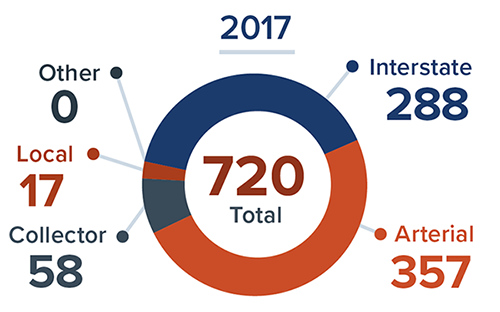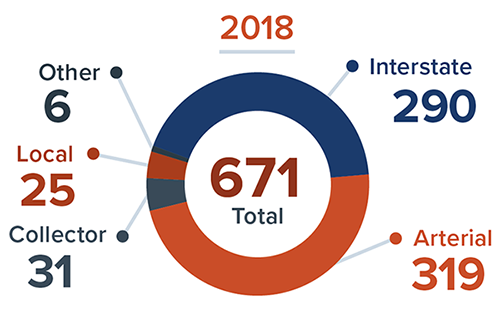National Work Zone Awareness Week
Safe Work Zones for All: We Can Do It
Printable Version [PDF, 752 KB]
You may need the Adobe® Reader® to view the PDFs on this page.
Contact Information: Operations Feedback at OperationsFeedback@dot.gov

U.S. Department of Transportation
Federal Highway Administration
Office of Operations
1200 New Jersey Avenue, SE
Washington, DC 20590
April 2020
FHWA-HOP-20-024
April 20–24, 2020
Work zones are a necessary part of the life cycle of our streets, roads, and highways. They provide a safe area for workers and a safe route for road users around needed road work activity (construction, maintenance, utility). Although work zones play a critical role, they can also be a major cause of congestion and delay.
Every spring, the Federal Highway Administration (FHWA) and its partners sponsor National Work Zone Awareness Week, to bring attention to motorist and worker safety and mobility issues in and around work zones.
Crashes in and around work zones impact everyone. We must protect workers. We must protect road users.
We must have safe work zones for all. We can do it!
To protect workers and road users, follow these tips for safe travel through work zones
Be Prepared. Before hitting the road, check phone apps, transportation agency websites, and the radio for the latest traffic information. With knowledge of active work zones, you can better plan your trip. Change your start time or, if possible, find alternative routes that avoid work zones altogether.
Wear Your Seatbelt. Seatbelts save lives. They are your best defense in a crash.
Stay Focused. Watch the road and not your phone. Work zones can change daily; pay attention so you can anticipate new traffic patterns.
Be Alert. Be aware of all activity occurring around you, including paying attention to other drivers.
Slow Down and Don’t Tailgate. Speeding and tailgating can lead to crashes with other vehicles and with field workers. In 2018, 21 percent of fatal work zone crashes involved rear-end collisions.1 Obey the posted work zone speed limits and keep a safe distance from the vehicle ahead of you.
Obey Road Crews and Signs. Cones, barrels, and warning signs help facilitate the movement of traffic in and around work zones. Flaggers are there to get you safely through the work zone.
Watch for Workers. Every year, workers are fatally injured by traveling vehicles in work zones. In 2018 alone, 124 workers were killed in work zone crashes.2
Share the Road. When you see passing work crews and official vehicles with flashing warning lights, move over to allow them to pass. It’s the law.
Use Caution Around Large Vehicles. Large vehicles have a slower reaction time, so refrain from making sudden lane changes in front of trucks that are trying to slow down.
Remember, Protect Everyone. Be respectful of workers and fellow drivers. We need everyone to work together to ensure we are all protected in work zones.
Visit the FHWA Work Zone Management website at www.fhwa.dot.gov/workzones and the National Work Zone Safety Information Clearinghouse website at www.workzonesafety.org/ for access to resources, guidance, and training.
TOTAL WORK ZONE FATALITIES by transportation mode1
| 2017 | 2018 | |
|---|---|---|
| 809 | 754 | |
| Drivers and passengers |
667 | 619 |
| Pedestrians and bicyclists |
138 | 130 |
| Others |
4 | 5 |
TOTAL WORK ZONE FATAL CRASHES by type of roadway1
|
2017 | 2018 |
|---|---|---|
Fatal work zone crashes involving large trucks or buses1 |
227 | 211 |
Worker fatalities in road construction sites2 |
132 | 124 |
|
59 | 58 |
|
11 | 12 |
|
62 | 54 |
Percentage of fatal work zone crashes where speeding was a factor1 |
29.3% | 25.5% |
2017–2018 trends: Relative to 2017, 2018 saw several favorable trends in a decreased number of work zone fatalities and fatal work zone crashes. Total work zone fatalities and fatal work zone crashes decreased by nearly seven percent, and the number of fatal work zone crashes involving large trucks or buses decreased by six percent. In 2018, there were decreases in both fatal work zone crashes where speeding was involved and worker fatalities on road construction sites. However, the number of worker fatalities due to vehicles running over or backing over a worker was unchanged from 2017 to 2018.
1 Fatality Analysis Reporting System (FARS) 2017 Final and 2018 Annual Report File, National Highway Traffic Safety Administration. FARS data shown here are from the 50 States, the District of Columbia, and Puerto Rico. [Return to First Note 1]
2 2017 and 2018 Census of Fatal Occupational Injuries, U.S. Department of Labor, Bureau of Labor Statistics, in cooperation with States, New York City, the District of Columbia, and Federal agencies.. [Return to First Note 2]
Note: Figures are subject to revision, as values reported in FARS may be updated intermittently. Values shown here reflect what is reported by NHTSA as of October 2019


